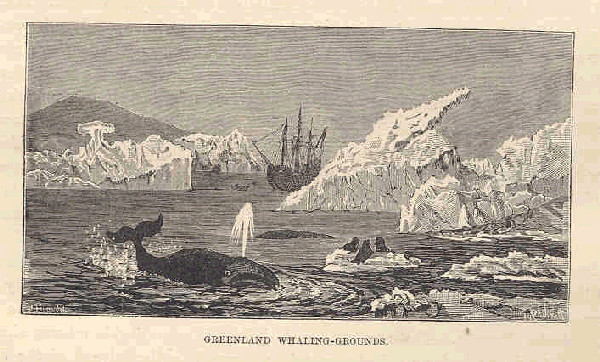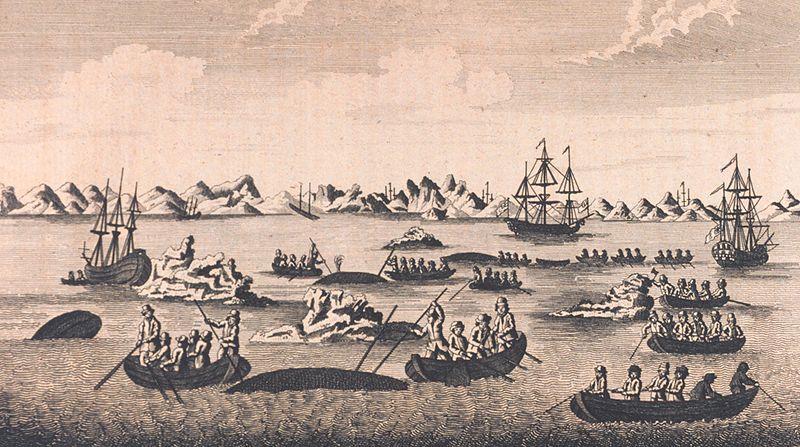Difference between revisions of "Whaling in London"
From Londonhua WIKI
Mthatfalvi (talk | contribs) |
Mthatfalvi (talk | contribs) (→Death of Whaling) |
||
| Line 38: | Line 38: | ||
In 1750, whale oil was being used for street lighting, machine lubricating in paint and putty. <ref name = "wal"/> Then the oil was replaced by gas and alternative oil sources. This brought the end to the big whaling industry in London and the last whale ship was sent out in 1835. | In 1750, whale oil was being used for street lighting, machine lubricating in paint and putty. <ref name = "wal"/> Then the oil was replaced by gas and alternative oil sources. This brought the end to the big whaling industry in London and the last whale ship was sent out in 1835. | ||
<br><br> | <br><br> | ||
| + | ===South Sea Whaling=== | ||
| + | One of the many different docks in London, The Greenland Dock was London's second wet dock established between 1696-1699. It was created to refit ships, specifically East India ships, and not cargo similar to the Blackwall Yard Dock built in 1660. The dock is located at Rotherhithe and built originally as the Howland Great Dock. It was originally named after Elizabeth Howland, granddaughter of Sir Josiah Child, the dictatorial chairman of East India Company. And after she was married money was raised to build the dock and add a second dry dock on the Howland's Rotherhithe estate. It was originally used to refit East India ships but by 1720s Greenland whalers also used the dock which led to the construction of blubber boiling houses on the south side. | ||
| + | |||
| + | The South Sea Company financed 172 unprofitable whaling ships from the dock between 1725-1732. The company did so because of the import duty exemption and the fact Greenland 'right whale' had become prized for its oil rich blubber and whalebone. In this little gallery are two Narwhal tusks from the late 18th century. Narwhals are a part of the dolphin family and were considered lucky by whalemen since they signaled presence of Greenland whales. The narwhal tusks, such as the ones on display, are made of high quality ivory and made the whalemen refer to narwhals 'unicorns'. Also, narwhal blubber created a high grade oil. To find out more about the whaling history in London click here. | ||
=References= | =References= | ||
Revision as of 15:56, 14 June 2017
Whaling in London
 Greenland Whaling | |
| Greenland Whaling | |
|---|---|
| Artist | Attributed to Frederick Whymper |
| Year | 1883 |
Overview
Whaling is a practice from back in the middle ages. In the 17th century, English whalers from the Greenland company started whaling.Overall, the whaling trade has periods of grown and decline. In the time of 1750, whale oil was used for street lighting, lubricating machinery, in paint and putty The whaling trade in London since the 1960's has closed due to other better sources of oil.
Contents
Background
Beginning of Whaling
According to the London Waling Trade article on the London Port Cities website, the Middle Ages saw the start of the hunting of whales in the Bay of Biscay by Basque fishermen. [1] Then in the 17th century, English and Dutch whalers working for the Muscovy Company started searching in the Arctic for whales to trade with Russia.
Greenland Whaling
The Greenland Company took over the whaling side of the Muscovy Company because it was granted monopoly rights given by the government. London then had 20 whaling ships in the 1620s. During this whaling time though the English had bitter competition with the Dutch who eventually dominant them by mid 17th century.
Death of Whaling
In 1750, whale oil was being used for street lighting, machine lubricating in paint and putty. [1] Then the oil was replaced by gas and alternative oil sources. This brought the end to the big whaling industry in London and the last whale ship was sent out in 1835.
South Sea Whaling
One of the many different docks in London, The Greenland Dock was London's second wet dock established between 1696-1699. It was created to refit ships, specifically East India ships, and not cargo similar to the Blackwall Yard Dock built in 1660. The dock is located at Rotherhithe and built originally as the Howland Great Dock. It was originally named after Elizabeth Howland, granddaughter of Sir Josiah Child, the dictatorial chairman of East India Company. And after she was married money was raised to build the dock and add a second dry dock on the Howland's Rotherhithe estate. It was originally used to refit East India ships but by 1720s Greenland whalers also used the dock which led to the construction of blubber boiling houses on the south side.
The South Sea Company financed 172 unprofitable whaling ships from the dock between 1725-1732. The company did so because of the import duty exemption and the fact Greenland 'right whale' had become prized for its oil rich blubber and whalebone. In this little gallery are two Narwhal tusks from the late 18th century. Narwhals are a part of the dolphin family and were considered lucky by whalemen since they signaled presence of Greenland whales. The narwhal tusks, such as the ones on display, are made of high quality ivory and made the whalemen refer to narwhals 'unicorns'. Also, narwhal blubber created a high grade oil. To find out more about the whaling history in London click here.
References
- ↑ 1.0 1.1 The London whaling trade. (n.d.). Retrieved May 23, 2017, from http://www.portcities.org.uk/london/server/show/ConNarrative.129/chapterId/2633/The-London-whaling-trade.html
